Set Up OpenStreetMap (OSM) Tile Server on Debian 11 Bullseye
OpenStreetMap (OSM) is a user-contributed, freely-editable world map. You can think of it as an open-source and self-hosted alternative to Google Maps. This tutorial will show you how to build your own OpenStreetMap tile server on Debian 11 so you don’t have to use a proprietary map service.
OpenStreetMap Features
- OpenStreetMap data covers the whole world, making it easy to support users in any country or every country.
- OpenStreetMap is updated every minute of every hour of every day, and these updates are available to you in real-time.
- OpenStreetMap data is free and open – there is no subscription fee and no page-view fee.
- OpenStreetMap data is rich and detailed, containing huge amounts of data that is relevant to people on the ground – the people who collected it.
Prerequisites/Hardware Requirements
The required RAM and disk space depend on which country’s map you are going to use. For example,
- The UK map requires at least 12G RAM and 100GB disk space.
- The whole planet map requires at least 32G RAM and 1TB SSD (Solid State Drive). It’s not viable to use a spinning hard disk for the whole planet map.
You will need more disk space if you are going to pre-render tiles to speed up map loading in the web browser, which is highly recommended. Check this tile disk usage page to see how much disk space are required for pre-rendering tiles. For example, if you are going to pre-render tiles from zoom level 0 to zoom level 15 for the planet map, an extra 460 GB disk space is required.
Another thing to note is that importing large map data, like the whole planet, to PostgreSQL database takes a long time. Consider adding more RAM and especially using SSD instead of spinning hard disk to speed up the import process.
If you are going to host the entire world map, I recommend you buy the extra-large VPS from Contabo, which boasts
- A 10 core CPU
- 60 GB RAM
- 1.6 TB Intel Optane SSD
It costs just 26.99 €/month.
Step 1: Upgrade Software
It’s always a good practice to update server software before doing any major work on your server. Log into your server via SSH and run the following command.
sudo apt update; sudo apt upgrade
Step 2: Install PostgreSQL Database Server and the PostGIS Extension
We will use PostgreSQL to store map data. The PostgreSQL team always strives to make performance improvements with every new version. Run the following commands to install the latest version of PostgreSQL.
echo "deb [signed-by=/etc/apt/keyrings/postgresql.asc] http://apt.postgresql.org/pub/repos/apt $(lsb_release -cs)-pgdg main" | sudo tee /etc/apt/sources.list.d/pgdg.list sudo mkdir -p /etc/apt/keyrings/ wget --quiet -O - https://www.postgresql.org/media/keys/ACCC4CF8.asc | sudo tee /etc/apt/keyrings/postgresql.asc sudo apt update sudo apt install -y postgresql postgresql-contrib postgresql-15 postgresql-client-15
Then install PostGIS, which is a geospatial extension to PostgreSQL.
sudo apt install postgis postgresql-15-postgis-3
PostgreSQL database server will automatically start and listens on 127.0.0.1:5432. The postgres user will be created on the OS during the installation process. It’s the super user for PostgreSQL database server. By default, this user has no password and there’s no need to set one because you can use sudo to switch to the postgres user and log into PostgreSQL server.
sudo -u postgres -i
Now you can create a PostgreSQL database user osm.
createuser osm
Then create a database named gis and at the same time make osm as the owner of the database. -E UTF8 specifies the character encoding scheme to be used in the database is UTF8.
createdb -E UTF8 -O osm gis
Next, create the postgis and hstore extension for the gis database.
psql -c "CREATE EXTENSION postgis;" -d gis psql -c "CREATE EXTENSION hstore;" -d gis
Set osm as the table owner.
psql -c "ALTER TABLE spatial_ref_sys OWNER TO osm;" -d gis
Exit from the postgres user.
exit
Create osm user on your operating system so the tile server can run as osm user. The following command will create a system user without password.
sudo adduser --system --group osm
Step 3: Download Map Stylesheet and Map Data
Change to osm’s home directory.
cd /home/osm/
Download the latest CartoCSS map stylesheets to the osm user’s home directory with git.
sudo apt install git git clone https://github.com/gravitystorm/openstreetmap-carto.git
If you see “permission denied” error while running the above command, then you can grant permissions with the following command. Replace username with your real username.
sudo apt install acl
sudo setfacl -R -m u:username:rwx /home/osm/
Then run one of the following commands to download the map data in PBF (ProtoBufBinary) format.
Britain and Ireland (1.7G)
wget -c http://download.geofabrik.de/europe/britain-and-ireland-latest.osm.pbf
Europe (25.8G)
wget -c http://download.geofabrik.de/europe-latest.osm.pbf
North America (11.8G)
wget -c http://download.geofabrik.de/north-america-latest.osm.pbf
South America (2.9G)
wget -c http://download.geofabrik.de/south-america-latest.osm.pbf
Central America (570MB)
wget -c http://download.geofabrik.de/central-america-latest.osm.pbf
Asia (11.2G)
wget -c http://download.geofabrik.de/asia-latest.osm.pbf
Africa (5.5G)
wget -c http://download.geofabrik.de/africa-latest.osm.pbf
Whole planet (66G). Note: I recommend only downloading the whole plant map when you really need to display the map of the whole world, or you will waste time waiting for the tile server to process unnecessary data.
wget -c http://planet.openstreetmap.org/pbf/planet-latest.osm.pbf
or
wget -c https://download.bbbike.org/osm/planet/planet-latest.osm.pbf
If you want other map of individual country/state/province/city, go to http://download.geofabrik.de. Also, BBBike.org provides extracts of more than 200 cities and regions worldwide in different formats.
Step 4: Optimize PostgreSQL Server Performance
The import process can take some time. To speed up this process, we can tune some PostgreSQL server settings to improve performance. Edit PostgreSQL main configuration file.
sudo nano /etc/postgresql/15/main/postgresql.conf
First, fine max_connections settings.
max_connections = 100
The default 100 connections might not enough for OpenStreetMap. Change it to 200.
max_connections = 200
Then we should change the value of shared_buffer. The default setting is:
shared_buffers = 128MB
This is too small. The rule of thumb is to set it to 25% of your total RAM (excluding swap space). For example, my VPS has 60G RAM, so I set it to:
shared_buffers = 15GB
Find the following line.
#work_mem = 4MB #maintenance_work_mem = 64MB
Again, the value is too small. I use the following settings.
work_mem = 1GB maintenance_work_mem = 8GB
Then find the following line.
#effective_cache_size = 4GB
If you have lots of RAM like I do, you can set a higher value for the effective_cache_size like 20G.
effective_cache_size = 20GB
Save and close the file. Restart PostgreSQL for the changes to take effect.
sudo systemctl restart postgresql
By default, PostgreSQL would try to use huge pages in RAM. However, Linux by default does not allocate huge pages. Check the process ID of PostgreSQL.
sudo head -1 /var/lib/postgresql/15/main/postmaster.pid
Sample output:
7031
Then check the VmPeak value of this process ID.
grep ^VmPeak /proc/7031/status
Sample output:
VmPeak: 16282784 kB
This is the peak memory size that will be used by PostgreSQL. Now check the size of huge page in Linux.
cat /proc/meminfo | grep -i huge
Sample output:
AnonHugePages: 0 kB ShmemHugePages: 0 kB HugePages_Total: 0 HugePages_Free: 0 HugePages_Rsvd: 0 HugePages_Surp: 0 Hugepagesize: 2048 kB Hugetlb: 0 kB
We can calculate how many huge pages we need. Divide the VmPeak value by the size of huge page: 16282784 kB / 2048 kB = 7950. Edit /etc/sysctl.conf file.
sudo nano /etc/sysctl.conf
Add the following line at the end of this file to allocate 7950 huge pages.
vm.nr_hugepages = 7950

Save and close the file. Then apply the changes.
sudo sysctl -p
If you check the meminfo again,
cat /proc/meminfo | grep -i huge
We can see there are 7950 huge pages available.
AnonHugePages: 0 kB ShmemHugePages: 0 kB HugePages_Total: 7950 HugePages_Free: 7950 HugePages_Rsvd: 0 HugePages_Surp: 0 Hugepagesize: 2048 kB
Restart PostgreSQL to use huge pages.
sudo systemctl restart postgresql
Use Screen on Remote Servers
Since the import process can take a long time and your computer might be disconnected from Internet, it’s recommended to use the screen utility to keep your session alive. Install screen on the Debian 11 server:
sudo apt install screen
Then start screen:
screen
Upon first launch, you will see an introduction text, simply press Enter to end. Then you will be able to run commands as usual.
Step 5: Import the Map Data to PostgreSQL
To import map data, we need to install osm2pgsql which converts OpenStreetMap data to postGIS-enabled PostgreSQL databases.
sudo apt install osm2pgsql
Grant permissions to the postgres user.
sudo setfacl -R -m u:postgres:rwx /home/osm/
Switch to the postgres user.
sudo -u postgres -i
Run the following command to load map stylesheet and map data into the gis database. Replace britain-and-ireland-latest.osm.pbf with your own map data file.
osm2pgsql --slim -d gis --hstore --multi-geometry --number-processes 10 --tag-transform-script /home/osm/openstreetmap-carto/openstreetmap-carto.lua --style /home/osm/openstreetmap-carto/openstreetmap-carto.style -C 32000 /home/osm/britain-and-ireland-latest.osm.pbf
where
--slim: run in slim mode rather than normal mode. This option is needed if you want to update the map data using OSM change files (OSC) in the future.-d gis: select database.--hstore: add tags without column to an additional hstore (key/value) column to PostgreSQL tables--multi-geometry: generate multi-geometry features in postgresql tables.--style: specify the location of style file--number-processes: number of CPU cores on your server. I have 10.-Cflag specifies the cache size in MegaBytes. It should be around 70% of the free RAM on your machine. Bigger cache size results in faster import speed. For example, my server has 60GB free RAM, so I can specify-C 32000. Be aware that PostgreSQL will need RAM for shared_buffers. Use this formula to calculate how big the cache size should be:(Total RAM - PostgreSQL shared_buffers) * 70%- Finally, you need to specify the location of map data file.
Command Output:
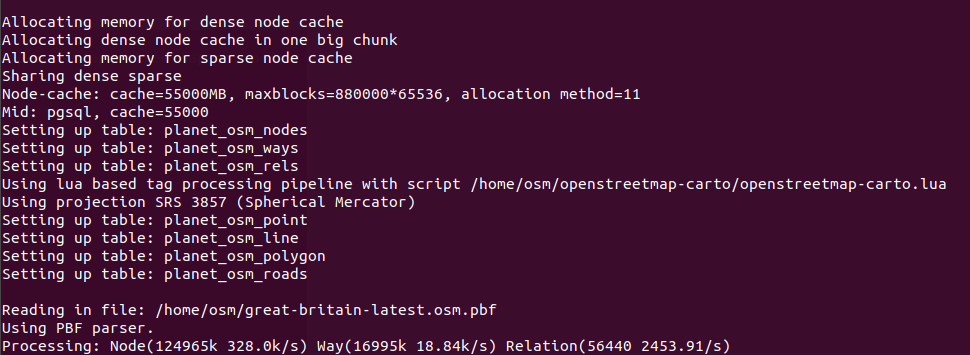
If you are going to import the full planet map data, then use the --drop option and the --flat-nodes option to increase the import speed. Note that the --flat-nodes option isn’t suitable for small maps.
osm2pgsql --slim -d gis --drop --flat-nodes /home/osm/nodes.cache --hstore --multi-geometry --number-processes 10 --tag-transform-script /home/osm/openstreetmap-carto/openstreetmap-carto.lua --style /home/osm/openstreetmap-carto/openstreetmap-carto.style -C 32000 /home/osm/planet-latest.osm.pbf
RAM usage will gradually increase during the importing process.
Now you probably don’t need to do other things on your server. Since you are using Screen, you can press Ctrl+A, release those keys, and then press D key to detach from the current Screen session. You will see a message like below.
[detached from 32113.pts-1.focal]
This tells me that the previous Screen session ID is 32113. You can log out from the SSH session and even shut down your computer. Don’t worry, the OSM import process is still running. When you need to come back and check the import progress, SSH into your server and run the following command to get the previous Screen Session ID.
screen -ls
Sample output:
There is a screen on: 32113.pts-1.focal (05/19/2020 03:45:29 PM) (Detached) 1 Socket in /run/screen/S-linuxbabe.
Then you can re-attach to the previous Screen session.
screen -r 32113
And you will be able to continue your work. Once the import is complete, grant all privileges of the gis database to the osm user.
psql -c "GRANT ALL PRIVILEGES ON ALL TABLES IN SCHEMA public TO osm;" -d gis
Exit from the postgres user.
exit
Note: If the osm2pgsql import isn’t finished yet, please don’t continue with step 6.
Troubleshooting
If you encounter the following error when importing map data from PBF file,
PBF error : invalid Blobheader size (> max_blob_header_size)
it’s probably because your PBF file is corrupt. Verify the md5sum of the PBF file like below.
md5sum great-britain-latest.osm.pbf
Compare the result with the md5sum value on the PBF file download page.
Step 6: Install Renderd and mod_tile
renderdis a daemon for rendering OpenStreetMap tiles from the PostgreSQL database.mod_tileis an Apache module that is used to serve tiles to clients (e.g. web browsers)
We can install them from the default Debian 11 software repository.
sudo apt install apache2 libapache2-mod-tile renderd
A config file for renderd will be created at /etc/apache2/conf-available/renderd.conf. Enable the tile module.
sudo a2enmod tile
Next, create a virtual host for the tile server.
sudo nano /etc/apache2/sites-available/tileserver_site.conf
Add the following lines in this file. Replace tile.your-domain.com with your real domain name. Don’t forget to DNS A record.
<VirtualHost *:80>
ServerName tile.your-domain.com
LogLevel info
Include /etc/apache2/conf-available/renderd.conf
</VirtualHost>
Save and close the file. Enable this virtual host.
sudo a2ensite tileserver_site.conf
Restart Apache for the changes to take effect.
sudo systemctl restart apache2
The render daemon will automatically start, as can be seen with:
systemctl status renderd
Step 7: Generate Mapnik Stylesheet
Install the required packages.
sudo apt install curl unzip gdal-bin mapnik-utils libmapnik-dev python3-pip nodejs npm
Then install the carto package with npm.
sudo npm install -g carto
Install the yaml andpsycopg2 Python module.
sudo -H pip3 install pyyaml psycopg2==2.8.5
Switch to the postgres user.
sudo -u postgres -i
Cd into the carto style directory.
cd /home/osm/openstreetmap-carto/
Get shapefiles.
scripts/get-external-data.py
If you encounter the following error message while running the above command, then you have DNS issues. Simply wait for several minutes and run the Python script again.
Failed to establish a new connection: [Errno -3] Temporary failure in name resolution
Now build the Mapnik XML stylesheet with the carto map stylesheet compiler.
carto project.mml > style.xml
Grant all privileges of the gis database to the osm user.
psql -c "GRANT ALL PRIVILEGES ON ALL TABLES IN SCHEMA public TO osm;" -d gis
Exit from the postgres user.
exit
Step 8: Install Fonts
You need to install the fonts-dejavu package.
sudo apt install fonts-dejavu
To display non-Latin characters, install the following packages.
sudo apt install fonts-noto-cjk fonts-noto-cjk-extra fonts-noto-hinted fonts-noto-unhinted ttf-unifont
Step 9: Configure renderd
Edit renderd config file.
sudo nano /etc/renderd.conf
In the [renderd] section, change the number of threads according to the number of CPU cores on your server.
num_threads=10
Add a default layer. Lines beginning with semicolons (;) are comments.
; ADD YOUR LAYERS:
[default]
URI=/osm/
XML=/home/osm/openstreetmap-carto/style.xml
HOST=tile.your-domain.com
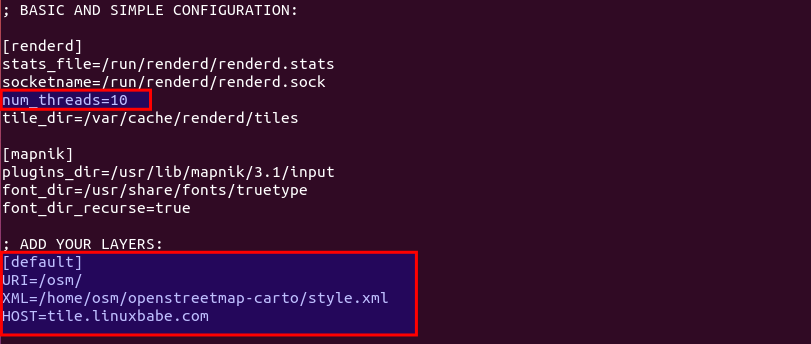
By default, renderd allows a max zoom level of 18. If you need zoom level 19, add the following line in the [default] section.
MAXZOOM=19
Save and close the file. Then create a new directory for the renderd service.
sudo mkdir /etc/systemd/system/renderd.service.d/
Create a custom config file under this directory.
sudo nano /etc/systemd/system/renderd.service.d/custom.conf
Add the following lines in this file.
[Service] User=osm
Save and close the file. Change the ownership of /run/renderd/ and /var/cache/renderd/tiles/ directory.
sudo chown osm /run/renderd/ -R sudo chown osm /var/cache/renderd/tiles/ -R
Then restart renderd service.
sudo systemctl daemon-reload sudo systemctl restart renderd
You need to check the log of renderd.
sudo journalctl -eu renderd
Make sure renderd does not produce any error in the log after the restart, or the map won’t be displayed.
Step 10: Test
In your web browser address bar, type
tile.your-domain.com/osm/0/0/0.png
You should see the tile of the world map. Congrats! You just successfully built your own OSM tile server.
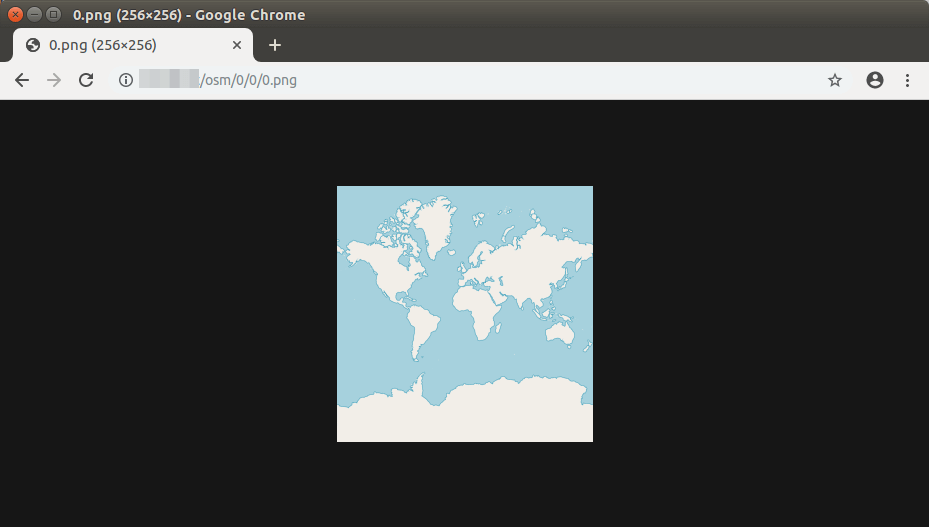
If you have enabled the UFW firewall, be sure to open port 80 and 443 with the following command.
sudo ufw allow 80,443/tcp
If you see the 404 not found error, simply wait a few minutes, refresh the page in your browser and it should be able to load the tile of world map. If it still won’t load, then restart renderd service (sudo systemctl restart renderd).
Step 11: Display Your Tiled Web Map
Now you have a working OSM tile server, you need to use a JavaScript map library to display the map on your other servers. In this tutorial, I’m creating the web map on the tile server, but you can do it on any other server.
A tiled web map is also known as a slippy map in OpenStreetMap terminology. There are two free and open-source JavaScript map libraries you can use for your tile server: OpenLayer and Leaflet. The advantage of Leaflet is that it is simple to use and your map will be mobile-friendly.
OpenLayer
To display your slippy map with OpenLayer, download JavaScript and CSS from openlayer.org and extract it to the webroot folder.
cd /var/www/html/ sudo wget https://github.com/openlayers/openlayers/releases/download/v5.3.0/v5.3.0.zip sudo unzip v5.3.0.zip
Next, create the index.html file.
sudo nano /var/www/html/index.html
Paste the following HTML code in the file. Replace red-colored text and adjust the longitude, latitude and zoom level according to your needs.
<!DOCTYPE html> <html> <head> <meta charset="UTF-8"> <title>Accessible Map</title> <link rel="stylesheet" href="http://tile.your-domain.com/v5.3.0/css/ol.css" type="text/css"> <script src="http://tile.your-domain.com/v5.3.0/build/ol.js"></script> <style> a.skiplink { position: absolute; clip: rect(1px, 1px, 1px, 1px); padding: 0; border: 0; height: 1px; width: 1px; overflow: hidden; } a.skiplink:focus { clip: auto; height: auto; width: auto; background-color: #fff; padding: 0.3em; } #map:focus { outline: #4A74A8 solid 0.15em; } </style> </head> <body> <a class="skiplink" href="#map">Go to map</a> <div id="map" class="map" tabindex="0"></div> <button id="zoom-out">Zoom out</button> <button id="zoom-in">Zoom in</button> <script> var map = new ol.Map({ layers: [ new ol.layer.Tile({ source: new ol.source.OSM({ url: 'http://tile.your-domain.com/osm/{z}/{x}/{y}.png' }) }) ], target: 'map', controls: ol.control.defaults({ attributionOptions: /** @type {olx.control.AttributionOptions} */ ({ collapsible: false }) }), view: new ol.View({ center: [244780.24508882355, 7386452.183179816], zoom:5 }) }); document.getElementById('zoom-out').onclick = function() { var view = map.getView(); var zoom = view.getZoom(); view.setZoom(zoom - 1); }; document.getElementById('zoom-in').onclick = function() { var view = map.getView(); var zoom = view.getZoom(); view.setZoom(zoom + 1); }; </script> </body> </html>
Save and close the file. Now you can view your slippy map by typing your sub-domain in the browser address bar.
tile.your-domain.com
or
tile.your-domain.com/index.html
Leaflet
To display your slippy map with Leftlet, download JavaScript and CSS from leftletjs.com and extract it to the webroot folder.
cd /var/www/html/ sudo wget http://cdn.leafletjs.com/leaflet/v1.7.1/leaflet.zip sudo unzip leaflet.zip
Next, create the index.html file. If there is already an index.html file, then delete the original content.
sudo nano /var/www/html/index.html
Paste the following HTML code in the file. Replace red-colored text and adjust the longitude, latitude and zoom level according to your needs.
<html>
<head>
<meta charset="UTF-8">
<title>My first osm</title>
<link rel="stylesheet" type="text/css" href="leaflet.css"/>
<script type="text/javascript" src="leaflet.js"></script>
<style>
#map{width:100%;height:100%}
</style>
</head>
<body>
<div id="map"></div>
<script>
var map = L.map('map').setView([55,0.8],6);
L.tileLayer('http://tile.your-domain.com/osm/{z}/{x}/{y}.png',{maxZoom:18}).addTo(map);
</script>
</body>
</html>
Save and close the file. Now you can view your slippy map by typing your server IP address in browser.
tile.your-domain.com
or
tile.your-domain.com/index.html
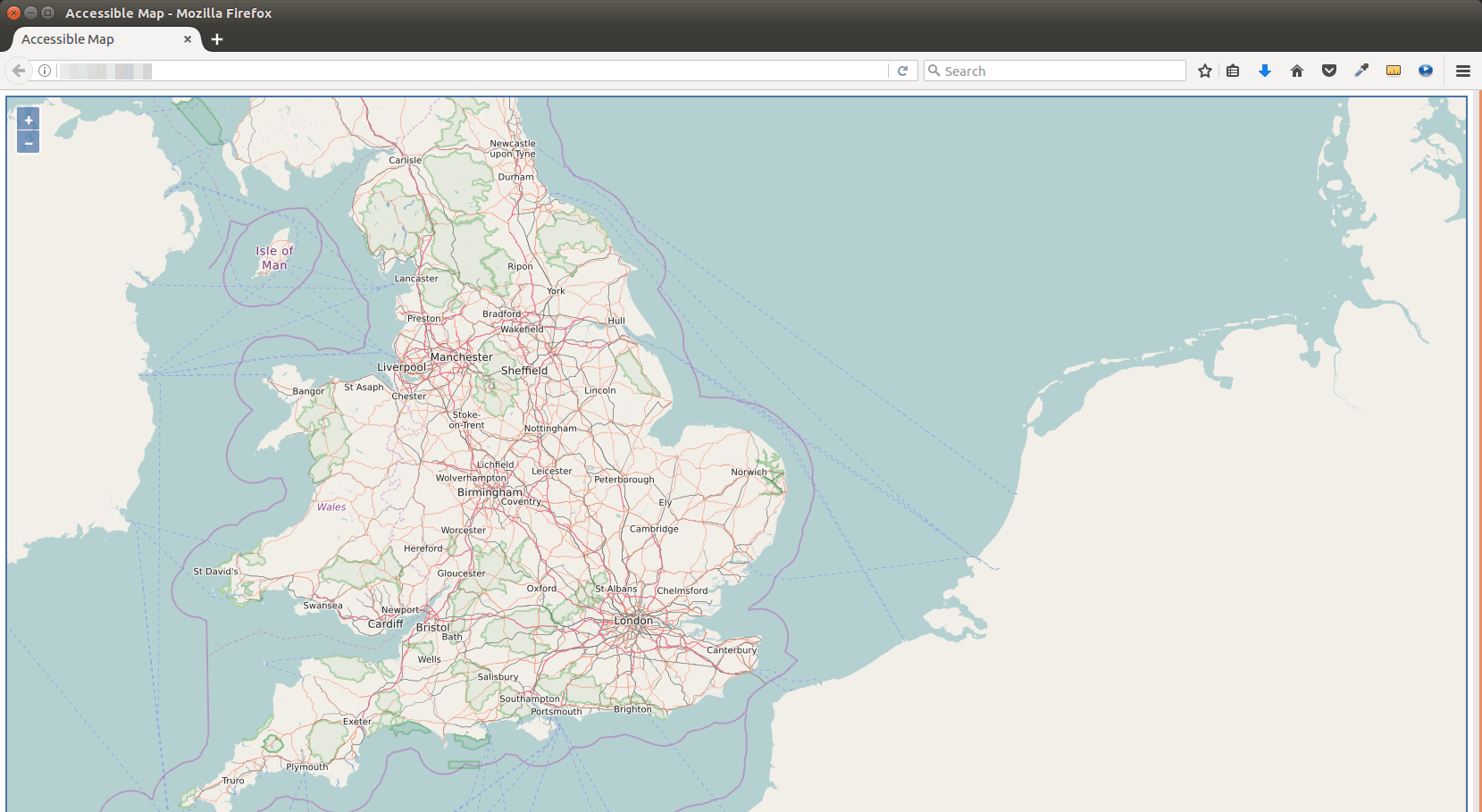
Step 12: Pre-render Tiles
Rendering tiles on-the-fly will increase the map loading time in web browser. To pre-render tiles instead of rendering on the fly, use the following render_list command. Use -z and -Z flag specify the zoom level and replace the number of threads according to the number of CPU cores on your server. Render_list renders a list of map tiles by sending requests to the rendering daemon. Pre-rendered tiles will be cached in /var/lib/mod_tile directory.
render_list -m default -a -z 0 -Z 19 --num-threads=10
If later you updated the map data, you can pre-render all tiles again by using the --force option.
render_list -m default -a -z 0 -Z 19 --num-threads=10 --force
To render map tiles in the background, add the & symbol at the end.
render_list -m default -a -z 0 -Z 19 --num-threads=10 &
Now you can close the terminal window. To check the rendering progress, open another SSH session, and run the following command.
sudo journalctl -eu renderd
The above command will show the latest log of the renderd service. The following lines show that my OSM server is now rendering map tiles at zoom level 12.
renderd[20838]: DEBUG: START TILE default 12 1008-1015 4056-4063, new metatile renderd[20838]: Rendering projected coordinates 12 1008 4056 -> -10175297.205328|-19724422.274944 -10097025.688364|-19646150.757980 to a 8 x 8 tile renderd[20838]: DEBUG: DONE TILE default 12 1008-1015 3984-3991 in 0.799 seconds renderd[20838]: DEBUG: Sending render cmd(3 default 12/1008/3984) with protocol version 2 to fd 18 renderd[20838]: DEBUG: Got incoming request with protocol version 2 renderd[20838]: DEBUG: Got command RenderBulk fd(18) xml(default), z(12), x(1008), y(4064), mime(image/png), options() renderd[20838]: DEBUG: START TILE default 12 1008-1015 4064-4071, new metatile renderd[20838]: Rendering projected coordinates 12 1008 4064 -> -10175297.205328|-19802693.791908 -10097025.688364|-19724422.274944 to a 8 x 8 tile
Step 13: Enable HTTPS
To encrypt HTTP traffic, we can obtain and install a free TLS certificate from Let’s Encrypt. I recommend installing the latest version of certbot from the Snap store.
sudo apt install snapd sudo snap install --classic certbot
Then run the following command to obtain and install TLS certificate.
sudo /snap/bin/certbot --apache --agree-tos --redirect --hsts --staple-ocsp --must-staple --email your-account@example.com -d tile.your-domain.com
Once the certificate is installed, refresh the web page and you will see a lock in the address bar.
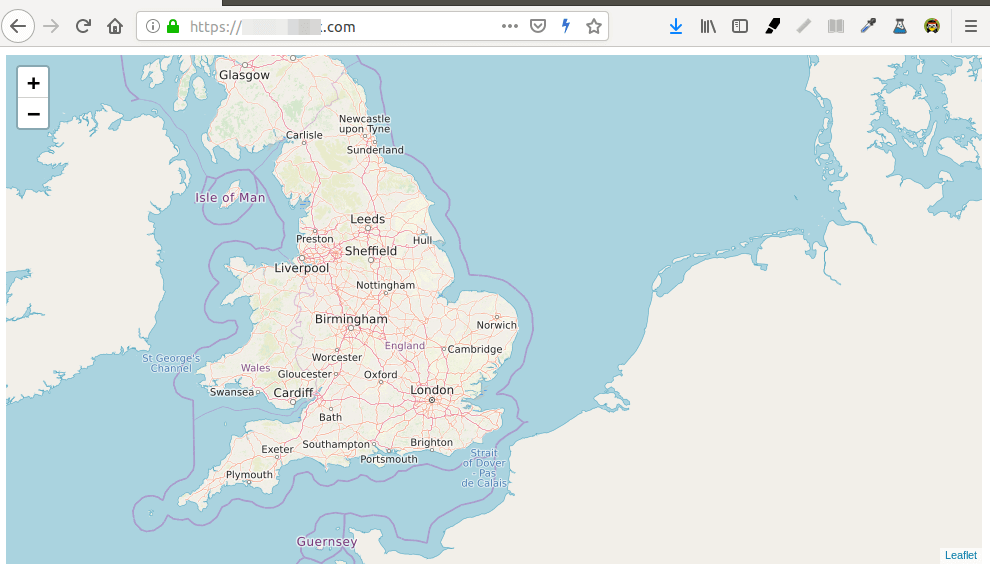
If you see a yellow triangle in Firefox address bar, that means the tile URLs are still using HTTP. You need to edit the index.html file and replace all HTTP protocol with HTTPS with the following command.
sudo sed -i 's/http/https/g' /var/www/index.html
Step 14: Enable HTTP2
To further improve map loading performance, you can enable HTTP2 protocol. First, you need to enable the HTTP2 module.
sudo a2enmod http2
Then open the SSL virtual host file.
sudo nano /etc/apache2/sites-enabled/tileserver_site-le-ssl.conf
Put the following directive after the opening <VirtualHost *:443> tag.
Protocols h2 http/1.1
Save and close the file. Then restart Apache for the changes to take effect.
sudo systemctl restart apache2
Restrict Access to Your OSM Tile Server with HTTP Referrer Header
By default, anyone can use OpenLayer or Leaflet to create a slippy map with the URL of your tile server. To restrict access to your tile server, edit the Apache virtual host file.
sudo nano /etc/apache2/sites-enabled/tileserver_site-le-ssl.conf
Add the following lines in the <VirtualHost> tags.
<Location /osm>
SetEnvIf Referer example\.com trusted_referer
Order deny,allow
Deny from all
Allow from env=trusted_referer
</Location>
The above code checks if the HTTP referer header includes your own domain. If not, access to the /osm directory will be denied. The backslash is used to escape the dot character. To add multiple hostnames as trusted referrers, use the following syntax.
SetEnvIf Referer (example\.com|www\.example\.com|map\.example\.com) trusted_referer
Save and close the file. Then test the syntax.
sudo apache2ctl -t
If the syntax is Ok, reload Apache for the changes to take effect.
sudo systemctl reload apache2
Auto-Renew TLS Certificate
You can create Cron job to automatically renew TLS certificate. Simply open root user’s crontab file.
sudo crontab -e
Add the following line at the bottom of the file.
@daily /snap/bin/certbot renew --quiet && systemctl reload apache2
PostgreSQL Database and Web Server on Different Hosts
If your PostgreSQL and Apache web server reside on different hosts, then you need to edit the project.mml file on the Apache host.
nano /home/osm/openstreetmap-carto-4.20.0/project.mml
Find the following lines:
osm2pgsql: &osm2pgsql type: "postgis" dbname: "gis" key_field: "" geometry_field: "way" extent: "-20037508,-20037508,20037508,20037508"
Specify the IP address of PostgreSQL database server.
osm2pgsql: &osm2pgsql
type: "postgis"
host: "10.0.0.2"
dbname: "gis"
key_field: ""
geometry_field: "way"
extent: "-20037508,-20037508,20037508,20037508"
Save and close the file. Then build the Mapnik XML stylesheet with the carto map stylesheet compiler.
carto project.mml > style.xml
On the PostgreSQL database server, edit the main configuration file.
sudo nano /etc/postgresql/12/main/postgresql.conf
Add the following line to set PostgreSQL to listen on all interfaces.
listen_addresses = '*'
Save and close the file. Then edit the PostgreSQL client authentication configuration file.
sudo nano /etc/postgresql/12/main/pg_hba.conf
Add the following line at the end of the file to allow the osm user to login from the Apache host. Replace 10.0.0.1 with the IP address of Apache host.
host gis osm 10.0.0.1/32 trust
Save and close the file. Then restart PostgreSQL.
sudo systemctl restart postgresql
Restart the render daemon on the Apache host.
sudo systemctl restart renderd
You need to check the log of renderd. Make sure renderd does not produce any error in the log, or the map won’t be displayed.
sudo journalctl -eu renderd
You should also restrict access to port 5432 of the PostgreSQL database server. For example, you can use the following UFW command to allow the IP address of Apache host only.
sudo ufw allow in from 10.0.0.1 to any port 5432
Wrapping Up
As always, if you found this post useful, then subscribe to our free newsletter to get more tips and tricks. Take care 🙂



All’s well until I get to section 7, mapnik
scripts/get-external-data.py
I get the errors
home/osm/openstreetmap-carto$ scripts/get-external-data.py
INFO:root:Starting load of external data into database
Traceback (most recent call last):
File “/home/osm/openstreetmap-carto/scripts/get-external-data.py”, line 405, in
main()
File “/home/osm/openstreetmap-carto/scripts/get-external-data.py”, line 291, in main
os.makedirs(data_dir, exist_ok=True)
File “/usr/lib/python3.9/os.py”, line 225, in makedirs
mkdir(name, mode)
PermissionError: [Errno 13] Permission denied: ‘data’
Anyone any ideas : Thanks David
Since this has to be executed by postgres, you have to make sure that postgres has writing-permissions in /home/osm .
I experienced the same problem. I solved it like this:
cd /home
chown -R postgres:postgres osm/